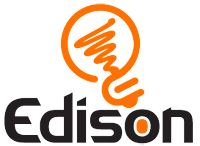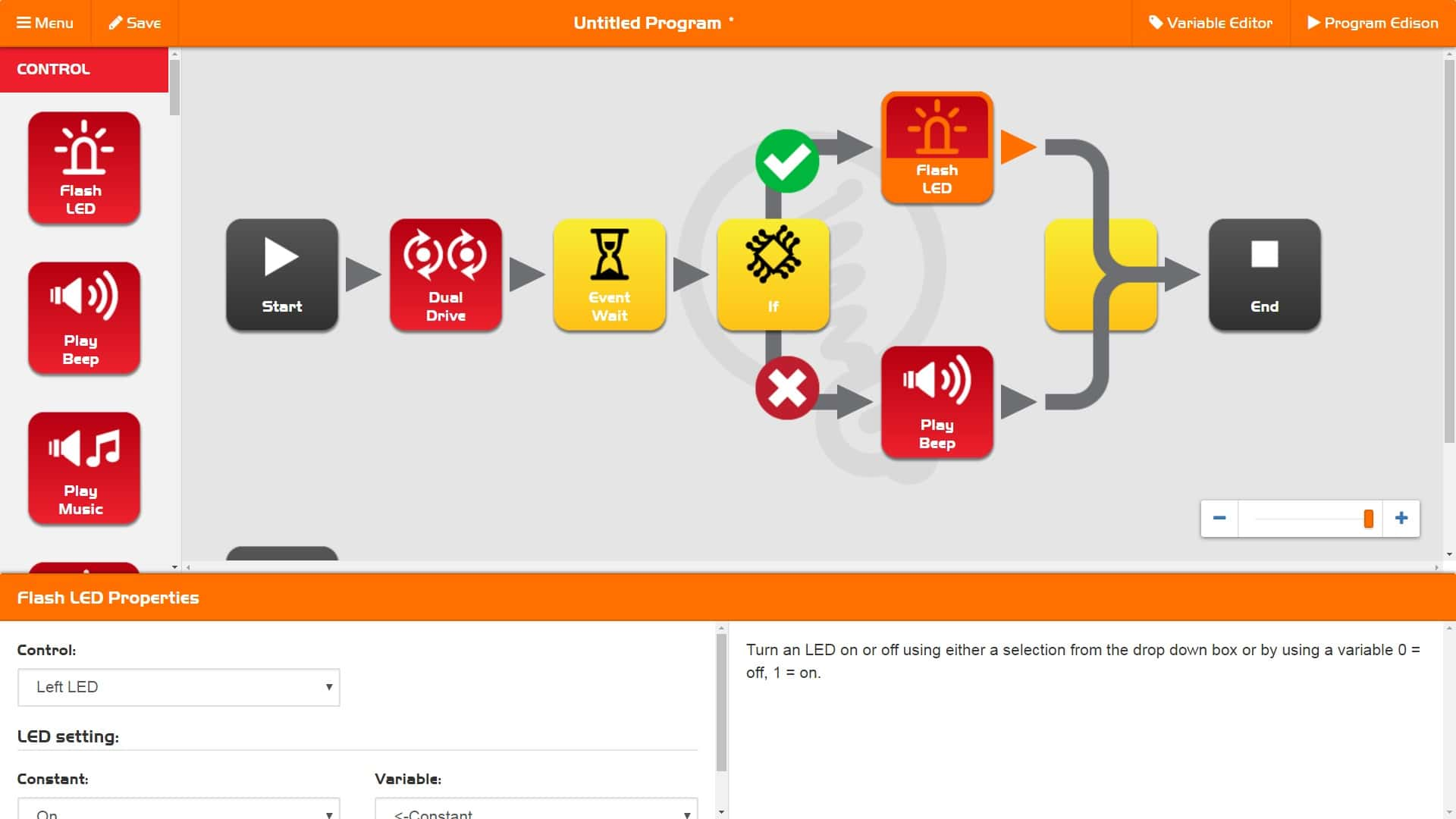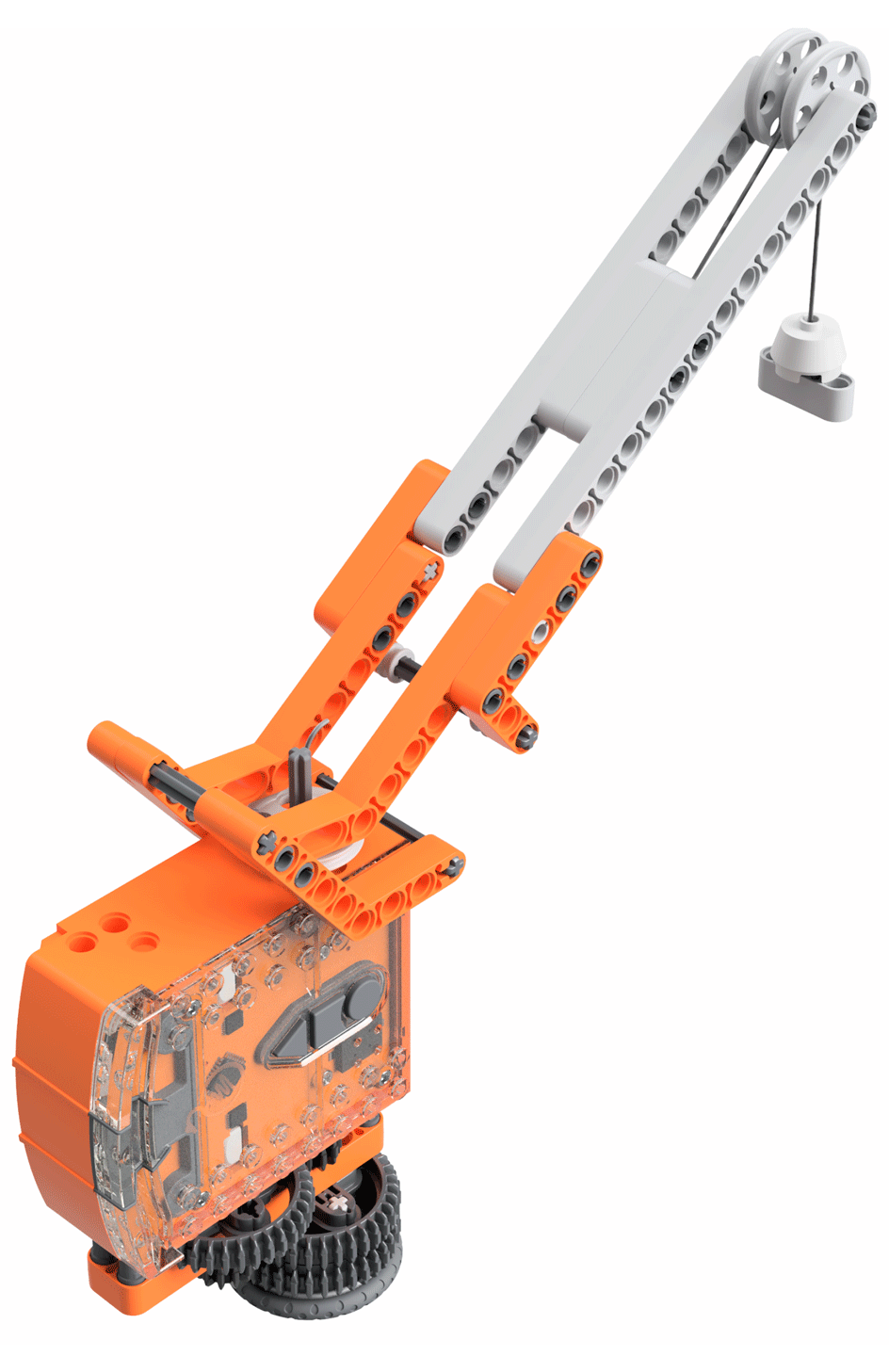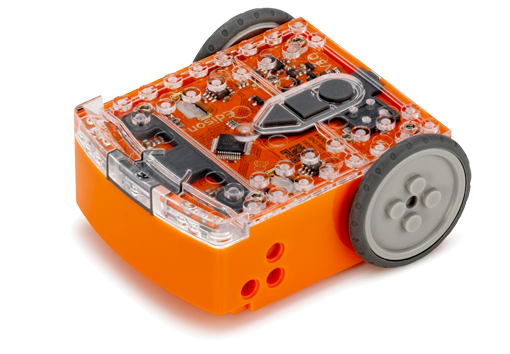EdWare programming language
EdWare was the original language for the Edison robot. EdWare has since been retired, replaced by three other languages: EdBlocks, EdScratch and EdPy. This page contains information and resources about EdWare accurate from when it was retired in August 2018.
The EdWare app (available at www.edwareapp.com) will continue to be active and available for use with Edison V1 and Edison V2 robots. While there is not currently a set time-frame for deactivating EdWare, we will not be updating the application moving forward. In other words, we plan on keeping the current application available as it stands indefinitely.
EdWare is a hybrid graphical robot programming language for the Edison robot. EdWare combines the ease of drag-and-drop graphical icons with increased functionality from text-based entry. The result is a robot programming language that is easy to learn and offers a robust next-step in coding education.
EdWare’s graphical icons are controlled by a unique feature, the properties box. This feature allows the main programming section to contain just a simple icon structure to represent the program, while the details of each icon are controlled individually in the properties box. EdWare allows users to create and control variables during the program flow, allowing Edison to have a ‘memory’ of past events and react in more interesting ways to sensor inputs.
You can access EdWare online at www.edwareapp.com
Getting started with EdWare
To help you get started using EdWare, we’ve created a free video tutorial series. Each of the short videos in the series will introduce an element of the EdWare environment to help you get the most out of using EdWare to program your Edison robot. Be sure to check out our YouTube channel for the other videos in the series too!
Resources
These free, downloadable resources can help you get the most out of EdWare.
Lesson plans
The EdWare lesson plans are designed to introduce programming using Edison and EdWare in a structured way. Each of the EdWare lessons has been designed to be completed in 90 minutes, however, the actual time required will vary based on your students’ ages and abilities.
Download the complete set of 10 lesson plans Complete 10 Lesson Plans
Download the EdWare worksheets (36) and activity sheets (5)
Curriculum linking guide
This resource serves as a guide as to how the EdWare lesson plans link to standards and requirements in the Australian Curriculum.
Download the EdWare lesson plan linking guide (Australian Curriculum)
Activity book
Take the exploration of robotics and coding even further! This activity book is perfect for additional independent exploration of Edison and EdWare beyond the lesson plans. Designed for use outside the classroom or as an independent extension, students will learn more about how to write their own robot controlling programs using the EdWare programming software.
Download the EdWare EdBook2 activity book: Your EdVenture into Robotics – You’re a Programmer
Download the robot programs from the EdWare EdBook2
Looking for EdBook3? The original EdBook3 required the LEGO Compact Tracked Loader kit, which has been discontinued by LEGO. You can still access the EdBook3 activity book here.
Additional EdWare programming projects with EdCreate
Give your students the opportunities to program solutions to real-world robotic challenges using EdWare and EdCreate, the Edison robot creator’s kit. Multiple programming challenges using the EdCreate EdBuilds are available in the EdCreate teaching guide. Or unlock your student’s creativity and EdWare programming prowess with the EdCreate EdChallenges!
Additional resources
Want to see what the barcode programs look like in EdWare? Download the EdWare robot programs from EdBook1
Download Complete 10 Lesson Plans (Word)
Download Worksheets (36) and Activity Sheets (5) (Word)
Download EdWare version 1.0.6 for Windows
Download EdWare version 1.0.7 SHORT PULSE for Windows
- NOTE: This version works well on devices with sound enhancement software, including most Windows desktop and laptop computers. If you are using a Windows desktop or laptop computer, the SHORT PULSE version should work best for your device.
NB- some devices have low audio output but also have sound enhancements. If you are using a Windows device with the SHORT PULSE EdWare installed and your program downloads are failing, switch to the EdWare version 1.0.6 for Windows option. If the EdWare version 1.0.6 for Windows option also fails, you will need to manually disable the sound enhancements on your device. Once these are disabled, use the EdWare version 1.0.6 for Windows option.
Download EdWare version 1.0.3 for Mac
Download EdWare version 1.0.6 for Linux
Download EdWare version 1.0.7 SHORT PULSE for Linux
- NOTE: This version works well on devices with sound enhancement software. If you are running a Linux machine and EdWare version 1.0.6 for Linux does not work, try this version instead.
NB- some devices have low audio output but also have sound enhancements. If you are using a Linux machine with the SHORT PULSE EdWare installed and your program downloads are failing, switch to the EdWare version 1.0.6 for Linux option. If the program fails using the 1.0.6 option, you will need to manually disable the sound enhancements on your device. Once these are disabled, use the 1.0.6 option.
Download EdWare for iOS from the App Store
Download EdWare version 1.0.3 for Raspberry Pi
Download the EdWare Tutorial Videos
Download the EdWare Apk for Android Tablets
Download the EdWare Test Program
Download the EdWare Icon Images
On the newer builds of the Raspberry Pi, the audio output is not high enough to program Edison, meaning additional amplification is required. This can be achieved by plugging Edison into a monitor connected via HDMI, the headphone jack of a powered set of speakers or USB sound card. Visit eBay for low-cost USB sound cards.
Source files
EdWare for PC, Mac and Linux is open source software. The source files can be downloaded from GitHub.
EdWare lessons in other languages
Download Sinu seiklus robootikas – 10 tunnikava (Estonian by Hasso Tepper)
Download Ontdek Edison in 10 lessen (Dutch by Bert Grave)
Download Ditt Robotik Edventyr – 10 Lektionsplaner (Swedish by Jennifer Lindholm)
Download Váš sprievodca svetom robotiky – 10 výučbových lekcií (Slovak by PaedDr. Peter Návoy)
Download 10LektionenPlan_Arbeitsblaeter (German by Cornelia Fahrni)
Download 10LektionenPlan_Begleitkommentar (German by Cornelia Fahrni)
Download 10LektionenPlan_UEbersicht (German by Cornelia Fahrni)
Download 10LektionenPlan_Kopiervorlagen (German by Cornelia Fahrni)
Download Robotbilim-icindeki-Edmaceralarınız-10-Ders-Planı (Turkish by Gökhan Kaya from STEM Makers Academy)
Download Robotbilim-icindeki-EdMaceralarınız-10-Ders-Planı-calisma-yapraklari (Turkish by Gökhan Kaya from STEM Makers Academy)
Download Tu-EdAventura-robotica-10-Lecciones Hojas-de-actividades (Spanish by Mario Ramos of Serendipity Learning Service, SL)
Download türkçe -Your-EdVenture-into-Robotics-10-Lesson-Plans (Turkish by Levent Yildiz from Kode Maker Akademi)
Download çalışma kitabı edison (Turkish by Levent Yildiz from Kode Maker Akademi)
Download Ditt-robot-eventyr-10-Leksjoners-Plan-arbeidsark (Norwegian by Robert Ronstad – Word doc)
Download Ditt-robot-eventyr-10-Leksjoners-Plan-arbeidsark (Norwegian by Robert Ronstad – PDF)
Download Your EdVenture in Robotics lesson plans and worksheets (Greek by Giorgos Nikolaidis – PDF & Word)
Please use, adapt and share!
We want to make robotics and computer science education available to everyone, which is why these teaching resources have been released under a Creative Commons licence. You are free to use these resources as they are, translate them, share them or use them as the base to develop your own customised lessons.

Your EdVenture into Robotics- 10 Lesson Plans by RoboticsWPS – Michele Miller is licensed under a Creative Commons Attribution-ShareAlike 4.0 International License.
Based on a work at https://www.meetedison.com.
You are free to:
Share — copy and redistribute the material in any medium or format
Adapt — remix, transform, and build upon the material for any purpose, even commercially.
Attribution — You must give appropriate credit, provide a link to the license, and indicate if changes were made. You may do so in any reasonable manner, but not in any way that suggests the licensor endorses you or your use.
ShareAlike — If you remix, transform, or build upon the material, you must distribute your contributions under the same license as the original.
Read the EdWare lessons online
Robotics Lesson plans overview
Most lessons have been designed to be completed in 90 minutes; however this will vary based on a student’s age and ability. All lesson plans have been linked to the Australian curriculum. Please see a complete list of references at meetedison.com.
Robotics Lesson 1: Get familiar and set up
Technology skills – Students familiarise themselves with the programming environment and how to download a program to the robot.
1. Set up and become familiar with Edison using barcode programs
2. Open software and become familiar with how to move icons
3. Download test program
Robotics Lesson 2: Robot movement – driving
Introduction to sequential programming – Students learn how the robot responds to command icons and bring together the concepts of time, speed and distance.
Program 1 – Drive the robot forward (Worksheet 2.1)
Program 2 – Drive the robot backward (Worksheet 2.2)
Program 3 – Drive the robot forward and backward (Worksheet 2.3)
Program 4 – Speed play (Worksheet 2.4)
Robotics Lesson 3: Robot movement – turning
Sequential programing and basic geometry – Students learn how the robot responds to time and geometry and how they can achieve driving control of the robot.
Program 1 – Right turn (Worksheet 3.1)
Program 2 – Left turn (Worksheet 3.2)
Program 3 – Right and then left turn (Worksheet 3.3)
Program 4 – Mini maze (Worksheet 3.4)
Robotics Lesson 4: Maze challenge and Mexican wave
Reinforce learning – Students use knowledge from lessons 1 through 3 to achieve two fun open ended activities.
Program 1– Driving challenge (Worksheet 4.1)
Program 2 – Mexican wave robot style (Worksheet 4.2)
Robotics Lesson 5: Design brief 1 – My program
Creative thinking and problem solving – Students come up with their own challenge and conceptualise how the robot can provide a solution. Students may select their own topic, state the program’s purpose and explain where it could be used in the real world.
1. Identify a problem that the robot can solve or a fun movement to music
2. Describe the problem or the movements the robot needs to make
3. Write the program and test it
4. Failure – The first attempt is never successful. Document it and Keep trying!
5. Describe the programming icons used and what they do
6. Demo – Students demonstrate their robot’s program to the class
Robotics Lesson 6: Clap sensing
Introduction to inputs (sensors) – Students learn how to make the robot respond to outside stimulus (claps). This lesson also includes a fun class activity.
Program 1 – Flash LED in response to a clap (Worksheet 6.1)
Program 2 – Drive in response to a clap (Worksheet 6.2)
Program 3 – Dance in response to clapping (Worksheet 6.3)
Robotics Lesson 7: Detect obstacles
Introduction to the concept of obstacle detection and artificial intelligence – Students program the robot to make decisions (artificial intelligence) in response to obstacles in the robot’s environment.
Understanding infrared obstacle detection (Worksheet 7.1)
Program 1 – Detect an obstacle and stop (Worksheet 7.2)
Program 2 – Detect an obstacle and avoid (Worksheet 7.3)
Program 3 – Detect an obstacle and avoid in a loop (Worksheet 7.4)
Program 4 – Right and left obstacle detection (Worksheet 7.5)
Robotics Lesson 8: Line sensing and tracking
Industrial like robotic behaviour – Students learn about basic robot sensing and control similar to that used in advanced automated factories and warehouses.
Understanding the line tracking sensor (Worksheet 8.1)
Program 1 – Drive until a black line (Worksheet 8.2)
Program 2 – Drive inside a border (Worksheet 8.3)
Program 3 – Follow a line (Worksheet 8.4)
Video – Humans need not apply
Robotics Lesson 9: Respond to light
Environmental measurement and programming mathematics – Students learn about measuring light levels, storing them in memory and performing mathematics to control the robots behaviour.
Understanding variables (Worksheet 9.1)
Program 1 – Light level alarm (Worksheet 9.2)
Program 2 – Automatic lights (Worksheet 9.3)
Program 3 – Light following (Worksheet 9.4)
Animal behaviours in robotics
Robotics Lesson 10: Design brief 2 – My program
Creative thinking and problem solving – This is the second design brief where students come up with their own challenge and conceptualise how the robot can provide a solution
1. Identify a problem that the robot can solve or action it can take
2. Describe the problem or the action the robot needs to make
3. Write the program and test it
4. Failure – The first attempt is never successful. Document it and Keep trying!
5. Describe the programming icons used and what they do
6. Demo – Students demonstrate their robot’s program to the class
Student achievement chart
Chart to track student achievement for each lesson
Edison robotics and programming course certificate
Student achievement certificate for robotics and programming



